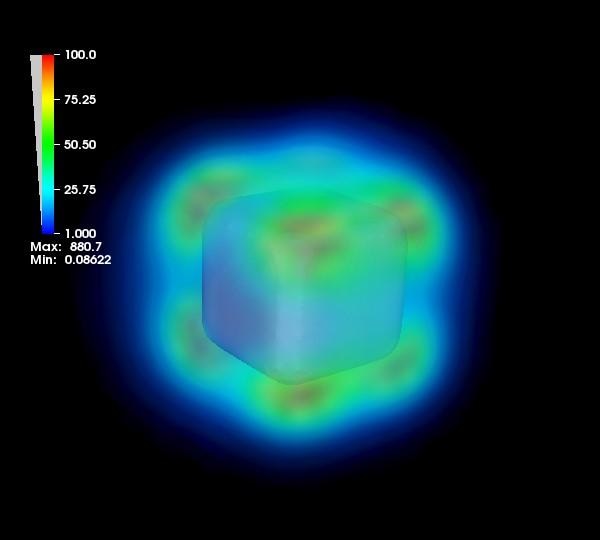Sep 1 2016
 Increased intensity of the electric field near the silver nanoparticle surface in the excitation of plasmon resonance. (Credit: Vladimir Bochenkov)
Increased intensity of the electric field near the silver nanoparticle surface in the excitation of plasmon resonance. (Credit: Vladimir Bochenkov)
A recent study deciphered how silver nanoparticles interacted with the cells of the immune system. This was achieved by Vladimir Bochenkov, a senior fellow at the Faculty of Chemistry, MSU, with colleagues from Denmark.
The study is published in the Nature Communications journal.
Currently, a large number of products are containing silver nanoparticles: antibacterial drugs, toothpaste, polishes, paints, filters, packaging, medical and textile items. The functioning of these products lies in the capacity of silver to dissolve under oxidation and form ions Ag+ with germicidal properties. At the same time there are research data in vitro, showing the silver nanoparticles toxicity for various organs, including the liver, brain and lungs. In this regard, it is essential to study the processes occurring with silver nanoparticles in biological environments, and the factors affecting their toxicity.
Vladimir Bochenkov, Senior Fellow, MSU
The research focused on the protein corona - a layer of adsorbed protein molecules that is produced on the surface of the silver nanoparticles during their contact with the biological environment, for instance in blood. Protein crown masks nanoparticles and often decides their fate: the momentum of the elimination from the body, the distribution between the organs, and the ability to pierce into a particular cell type.
According to the most recent research, the protein corona is made up of two layers: a soft corona, made up of weakly bound protein molecules in a dynamic equilibrium with the solution, and a stiff hard corona, made up of protein molecules firmly bound with silver nanoparticles.
Until now the soft corona has been explored very little due to experimental challenges: the weakly bound nanoparticles separated from the protein solution easily desorbed, leaving only the stiff corona on the nanoparticle surface.
The size of the silver nanoparticles that were analyzed measured 50 - 88 nm, and the diameter of the proteins that fabricated the crown measured 3 - 7 nm.
Scientists have analyzed the silver nanoparticles with the protein corona in situ, without removing them from the biological environment. The functions of the soft corona have beetested because of the localized surface plasmon resonance used to investigate the environment near the surface of the silver nanoparticles.
In the work we showed that the corona may affect the ability of the nanoparticles to dissolve to silver cations Ag+, which determine the toxic effect. In the absence of a soft corona (quickly sharing the medium protein layer with the environment) silver cations are associated with the sulfur-containing amino acids in serum medium, particularly cysteine and methionine, and precipitate as nanocrystals Ag2S in the hard corona.
Vladimir Bochenkov, Senior Fellow, MSU
Ag2S (silver sulfide) is known to easily form on the silver surface even on the air when there are traces of hydrogen sulfide.
Sulfur is also part of several biomolecules found within the body, pushing the silver to react and be changed into sulfide. When the nano-crystals Ag2S are formed due to low solubility, it decreases the bioavailability of the Ag+ ions, minimizing the toxicity of silver nanoparticles to null.
With an adequate quantity of amino acid sulfur sources present for reaction, all of the potentially toxic silver is changed into the nontoxic insoluble sulfide. Researchers have demonstrated that this is what occurs in the absence of a soft corona.
When a soft corona is present, the Ag2S silver sulfide nanocrystals are either formed in lower quantities or not produced at all. Researchers link this to the fact that the weakly bound protein molecules move the Ag+ ions from nanoparticles into the solution, ensuring that the sulfide is not crystallized. This makes the soft corona proteins 'vehicles' for the silver ions.
Researchers feel that this effect should be considered when testing the stability of silver nanoparticles in a protein environment, and in deciphering the findings of the toxicity studies.
Research on the cells viability of the immune system (J774 murine line macrophages) established the cutback in cell toxicity of silver nanoparticles at the sulfidation in the absence of a soft corona.
The difficulty Vladimir Bochenkov's has was reproducing the plasmon resonance spectra of the analyzed systems, and developing the theoretical model that facilitated quantitative determination of silver sulfide content in situ around nanoparticles, following the modification in the absorption bands in the trial spectra.
As the frequency of the plasmon resonance is sensitive to an alteration in dielectric constant near the nanoparticle surface, alterations in the absorption spectra possess data regarding the quantity of silver sulfide produced.
Having a clear understanding of the toxicity and dangers of nanoparticles in the human body depend upon the knowledge of the formation methods and dynamics of the behavior of the protein corona, as well as data relating to its composition and structure.
Protein corona formation has the potential to be used to deliver drugs in the body, including for the treatment of cancer. To achieve this, it is essential to choose a particular content of the protein corona, which would facilitate silver nanoparticles to penetrate only in the cancer cell and kill it.